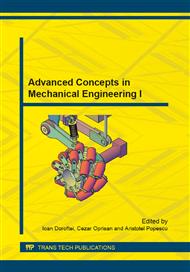[1]
P. Daponte, S. Rapuano, M. Riccio and F. Zoino, Remote Didactic Laboratory In Electronic Measurements: Quality Of System Testing, Proc. of Instrumentation and Measurement Technology Conference, IMTC 2007, Warsaw, Poland, 1–3 May, 2007, p.1–6.
DOI: 10.1109/imtc.2007.379422
Google Scholar
[2]
D. Grimaldi, S. Rapuano, Hardware And Software To Design Virtual Laboratory For Education In Instrumentation And Measurement, Measurement vol. 42, p.485–493, May (2009).
DOI: 10.1016/j.measurement.2008.09.003
Google Scholar
[3]
H. M. Huang, U. Rauch, S. S. Liaw, Investigating learners' attitudes toward virtual reality learning environments: Based on a constructivist approach, Computers & Education, vol. 55, pp.1171-1182, nov. (2010).
DOI: 10.1016/j.compedu.2010.05.014
Google Scholar
[4]
M. Hashemipour, H. Farahani, Manesh, M. Bal, A Modular Virtual Reality System for Engineering Laboratory Education, Computer App. In Eng. Ed. Vol. 19, pp.305-314, June (2011).
DOI: 10.1002/cae.20312
Google Scholar
[5]
Z. Pan, A. D. Cheok, H. Yang, J. Zhu, J. Shi, Virtual reality and mixed reality for virtual learning environments, Computers & Graphics vol. 30, p.20–28, February (2006).
DOI: 10.1016/j.cag.2005.10.004
Google Scholar
[6]
P. Simon, A. D. Cheok, F. Farzam, W. Todd, J. Nik, K. Hirokazu, 3-D live, real time interaction for mixed reality,. Proceedings of the ACM Conference on Computer Supported Cooperative Work, New Orleans, LA, USA, p.364–71, Nov. (2002).
DOI: 10.1145/587078.587129
Google Scholar
[7]
Y. Genc, S. Riedel, F. Souvannavong, C. Akinlar, N. Navab, Marker-less tracking for AR: a learning-based approach, in: Proc. of the International Symposium on Mixed and Augmented Reality (ISMAR), IEEE Computer Society, Darmstadt, Germany, p.295–304, oct-nov., (2002).
DOI: 10.1109/ismar.2002.1115122
Google Scholar
[8]
M. Berger, V. Lapetit, Handling occlusion in augmented reality systems: a semi-automatic method, in: Proceedings of the ISAR, 2000, IEEE Computer Society, USA, 2000, p.137–146.
DOI: 10.1109/isar.2000.880937
Google Scholar
[9]
P. Ebbesmeyer, J. Frund, C. Matysczok, AR-PDA — a personal digital assistant for VR/AR content, in: Proceedings of the ASME 2002 Design Engineering Technical Conferences and Computers and Information in Engineering Conference, Montreal, Canada, (2002).
DOI: 10.1115/detc2002/cie-34393
Google Scholar
[10]
W. Dangelmaier, M. Fischer, J. Gausemeier, M, Grafe, C. Matysczok, B. Mueck, Virtual and augmented reality support for discrete manufacturing system simulation, Computers in Industry, 56 (2005) p.371–383.
DOI: 10.1016/j.compind.2005.01.007
Google Scholar
[11]
J. Gausemeier, J. Frund, C. Matysczok, AR-planning tool-designing flexible manufacturing systems with augmented reality, in: Proceedings of the Eurographics Workshop on Virtual Environments, Eurographics Association, Aire-la-Ville, Switzerland, 2002, p.19.
Google Scholar
[12]
D. H. Shin, P. S. Dunston, Evaluation of Augmented Reality in steel column inspection, Automation in Construction 18 (2009) 118–129, Elsevier.
DOI: 10.1016/j.autcon.2008.05.007
Google Scholar
[13]
L, Cragg. H, Hu, Mobile agent approach to networked robots, Int. J. Adv. Manuf. Technol. 2006, 30: p.979–987.
DOI: 10.1007/s00170-005-0072-3
Google Scholar
[14]
H, Huosheng, Y, Lixiang, T. P, Wo, Z, Quan, Internet-based robotic systems for teleoperation, Assembly Automation; 2001, 21, 2; ProQuest Central pg. 143.
Google Scholar
[15]
M., Wang, J. N. K., Liu, Interactive control for Internet-based mobile robot teleoperation, Robotics and Autonomous Systems, Volume 52, Issues 2-3, 31 August 2005, Pages 160-179.
DOI: 10.1016/j.robot.2005.04.001
Google Scholar


